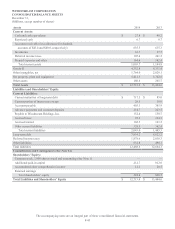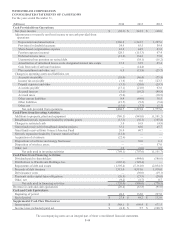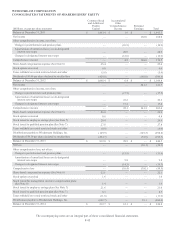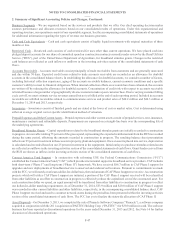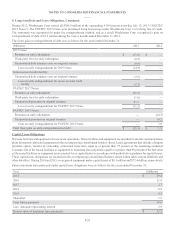Windstream 2014 Annual Report Download - page 166
Download and view the complete annual report
Please find page 166 of the 2014 Windstream annual report below. You can navigate through the pages in the report by either clicking on the pages listed below, or by using the keyword search tool below to find specific information within the annual report.
NOTES TO CONSOLIDATED FINANCIAL STATEMENTS
____
F-50
2. Summary of Significant Accounting Policies and Changes, Continued:
Revenue Recognition – Service revenues are primarily derived from providing access to or usage of our networks and facilities.
Service revenues are recognized over the period that the corresponding services are rendered to customers. Revenues that are
billed in advance include monthly recurring network access and data services, special access and monthly recurring voice, Internet
and other related charges. The unearned portion of these revenues is included in advance payments and customer deposits in the
accompanying consolidated balance sheets. Revenues derived from other telecommunications services, including interconnection,
long distance and enhanced service revenues are recognized monthly as services are provided. Revenue from sales of indefeasible
rights to use fiber optic network facilities (“IRUs”) and the related telecommunications network maintenance arrangements is
generally recognized over the term of the related lease or contract. Sales of communications products including customer premise
equipment and modems are recognized when products are delivered to and accepted by customers. Fees assessed to customers
for service activation are deferred upon service activation and recognized as service revenue on a straight-line basis over the
expected life of the customer relationship in accordance with authoritative guidance on multiple element arrangements. Certain
costs associated with activating such services are deferred and recognized as an operating expense over the same period.
In determining whether to include in revenues and expenses the taxes and surcharges assessed and collected from customers and
remitted to government authorities, including USF charges, sales, use, value added and excise taxes, we evaluate, among other
factors, whether we are the primary obligor or principal tax payer for the fees and taxes assessed in each jurisdiction in which we
operate. In those jurisdictions for which we are the primary obligor, we record the taxes and surcharges on a gross basis and include
in revenues and costs of services and products. In jurisdictions in which we function as a collection agent for the government
authority, we record the taxes on a net basis and exclude the amounts from our revenues and costs of services and products.
Advertising – Advertising costs are expensed as incurred. Advertising expense totaled $96.8 million, $80.4 million, and $99.5
million in 2014, 2013 and 2012.
Share-Based Compensation – In accordance with authoritative guidance on share-based compensation, we value all time-based
awards to employees at fair value on the date of the grant, and recognize that value as compensation expense over the period that
each award vests. Performance-based awards are valued at fair value at the end of each reporting period until final performance
targets are set. Share-based compensation expense for performance-based awards is recognized when it is probable and estimable
as measured against performance metrics. Share-based compensation expense is included in selling, general and administrative
expenses in the accompanying consolidated statements of operations.
Pension Benefits – We recognize changes in the fair value of plan assets and actuarial gains and losses due to actual experience
differing from actuarial assumptions, as a component of net periodic benefit (income) expense in the fourth quarter in the year in
which the gains and losses occur, and if applicable in any quarter in which an interim remeasurement is required. The remaining
components of net periodic benefit (income) expense, primarily service and interest costs and assumed return on plan assets, are
recognized ratably on a quarterly basis.
Operating Leases – Certain of our operating lease agreements include scheduled rent escalations during the initial lease term and/
or during succeeding optional renewal periods. We account for these operating leases in accordance with authoritative guidance
for operating leases with non-level rent payments. Accordingly, the scheduled increases in rent expense are recognized on a straight-
line basis over the initial lease term and those renewal periods that are reasonably assured. The difference between rent expense
and rent paid is recorded as deferred rent and is included in other liabilities in the accompanying consolidated balance sheets.
Leasehold improvements are amortized over the shorter of the estimated useful life of the asset or the lease term, including renewal
option periods that are reasonably assured.
Income Taxes – We account for income taxes in accordance with guidance on accounting for income taxes under the asset and
liability method. Deferred tax assets and liabilities are recognized for the estimated future tax consequences attributable to
differences between the financial statement carrying amounts of existing assets and liabilities and their respective tax bases.
Deferred tax balances are adjusted to reflect tax rates based on currently enacted tax laws, which will be in effect in the years in
which the temporary differences are expected to reverse. The effect on deferred tax assets and liabilities of a change in tax rates
is recognized in the results of operations in the period of the enactment date. A valuation allowance is recorded to reduce the
carrying amounts of deferred tax assets unless it is more likely than not that such assets will be realized. In addition, we adopted
authoritative guidance which addresses uncertainty in tax positions and clarifies the accounting for income taxes by prescribing
a minimum recognition threshold that the income tax positions must achieve before being recognized in the financial statements.





